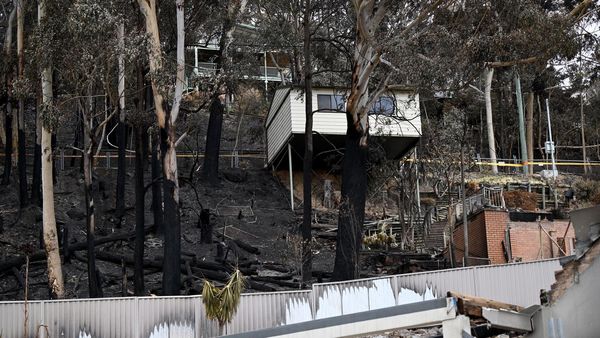
Late on Friday night, eight US B-2 bombers took off from Whiteman air force base in Missouri and turned westwards towards the Pacific. Amateur flight trackers plotted their progress on social media as the black flying-wing warplanes joined up mid-air with refuelling tankers and checked in with air traffic controllers once they had reached the open ocean.
The movement of the B-2 bombers towards the US Pacific base on Guam triggered speculation that Donald Trump was arranging pieces on the board before a decision on whether to join Israel in bombing Iranian nuclear facilities.
On Thursday, Trump had let it be known that he would make that decision over the following two weeks, suggesting a window remained open for some last-ditch diplomatic alternative to war. He angrily denied a Wall Street Journal report that he had already approved a strike plan.
The British, French and German foreign ministers seized the opportunity to meet their Iranian counterpart, Abbas Araghchi, for talks in Geneva on Friday but to little or no avail. Trump himself was characteristically dismissive of European efforts. “Nah, they didn’t help,” he told journalists.
We know now that and the B-2 flights over the Pacific were part of the same elaborate ruse to ensure Iran was off its guard and looking the wrong way, and that the president’s declared two-week diplomatic window was likely to be part of the same ploy.
The Pentagon described the eight bombers that were spotted flying west as a decoy, a deception effort known only to an extremely small number of planners and leaders in Washington and at central command headquarters in Tampa, Florida.
As they were tracked across the western states and then the Pacific, another seven B-2s took off from Whiteman base and headed in the opposite direction – eastwards. These seven planes made no communications with each other or with the ground as they crossed America and flew unnoticed over the Atlantic.
The planes and their two-pilot crews flew all day and into Saturday night, refuelled mid-air along the way by tankers that had been deployed to Europe over the previous week.
The careful orchestration and prepositioning, some of it predating the Israeli surprise attack on Iran on 13 June, raises questions over how early Trump and Benjamin Netanyahu decided to join forces to go to war against Iran, and over how much of the US president’s professed interest in a diplomatic solution, and apparent effort to discourage an Israeli attack, was all part of the charade.
As far back as May, during a visit to Doha, Trump went out of his way to denigrate the B-2’s design, declaring “I’m not a huge believer in stealth”, because it made for an “ugly plane”.
By the time the flight of seven of these ugly planes arrived in the Middle East at the eastern edge of the Mediterranean, it was midnight local time on Saturday. The mission they had been assigned was codenamed Midnight Hammer, and to carry it out the bombers were joined by an escort of US fighter jets, surveillance and reconnaissance planes deployed in the region earlier – 125 aircraft in all. Together they flew on eastwards, with hardly a word exchanged between the pilots, to maintain the all-enveloping secrecy surrounding the operation.
At the same time as the warplanes reached the Lebanese coast, a US submarine loitering somewhere in the Arabian Sea launched Tomahawk cruise missiles, synchronised to reach their targets in Iran at the same time the bombers arrived.
The Tomahawks flew low over the Gulf of Oman and up over south-east Iran as seven B-2s and their accompanying fighters crossed Lebanon, Syria and Iraq (according to a map provided by the Pentagon on Sunday) and entered Iran from the north-west at about 1.30am local time.
The chair of the US joint chiefs of staff, Dan Caine, described the whole operation as “a complex, tightly timed manoeuvre requiring exact synchronisation across multiple platforms in a narrow piece of airspace, all done with minimal communications”.
The primary target was the farthest north, near the Shia religious centre of Qom, the underground enrichment facility at Fordow, generally thought impregnable to every conventional weapon with the possible exception of America’s biggest bomb, the 30,000lb (13,500kg) GBU-57 Massive Ordnance Penetrator. The seven B-2s approaching from the north were each carrying two of them.
The second target was Natanz, Iran’s first enrichment facility, and the third was a complex of facilities outside the ancient city of Isfahan, which is linked to other parts of the nuclear fuel cycle, and which had already been partly damaged by Israeli bombing.
Before the bombers arrived at these targets, according to Caine’s account, their fighter escort swept the area for any sign of Iranian warplanes, released decoys and opened fire on air defence sites on the ground. Apparently, there was no return fire. The Pentagon was “unaware of any shots fired at the US strike package”. Iran’s defensive shield had been flattened over the preceding week by relentless Israeli sorties.
The bombers struck between 2.10am and 2.35am Iranian time, the Pentagon said, hitting Fordow at “several aim points”. It was the first time the enormous GBU-57 bunker-busting bomb had been used in a US operation. It is unclear how many of the total of 14 were dropped on Natanz or Isfahan. The Tomahawk missiles fired by the navy were all aimed at Isfahan, Caine said, and landed slightly after the other two facilities were struck.
The US warplanes turned around and headed back the way they had come, leaving Iranian airspace at 3am. By that time, reports had surfaced on Iranian media of explosions in the region of the nuclear facilities, and a quarter hour later, Trump confirmed the operation in the way he has made most of his presidential announcements – on his private online platform, Truth Social, complete with key words in all-capitals.
“A full payload of BOMBS was dropped on the primary site, Fordow,” Trump wrote. “All planes are safely on their way home. Congratulations to our great American Warriors. There is not another military in the World that could have done this. NOW IS THE TIME FOR PEACE!”
Addressing the nation a little later on television, Trump said the targets had been “totally and completely obliterated”, a claim that was modified over the course of Sunday to “severely damaged”.
The president appealed once more for Iran to sue for peace, which he has made clear would involve a surrender of all its nuclear programme. The message was repeated by other members of the administration throughout the day. Midnight Hammer would be a one-off US intervention, as long as Iran did not try to fire back and complied with the terms laid down by him and Netanyahu.
Any retaliation, Trump said, returning to all caps on Truth Social, would be met with “FORCE FAR GREATER THAN WHAT WAS WITNESSED TONIGHT”.
By the end of Sunday, however, there was no sign of compliance from Tehran. Araghchi, vowed that Midnight Hammer would have “everlasting consequences” adding that Iran reserved the right to “all options to defend its sovereignty, interest, and people”. Iran played down the impact of the US bombs, saying that the country’s reserves of high-enriched uranium had been removed from Fordow long before, and all the damage inflicted could be repaired.
On Sunday morning, Iran launched a new salvo of missiles at Israel, one of which flattened most of a city block in north Tel Aviv. By the end of the day, Iran’s parliament had approved a bill calling for the closing of the strait of Hormuz, the gateway to the Gulf, through which over a fifth of the world’s oil needs flows daily. Iran’s president, Masoud Pezeshkian, warned that the US must “receive a response” to its attacks.
Tehran has previously threatened to target US bases spread across eight countries in the region, if the US were to join the Israeli attacks. In reality, its military capabilities are constrained by the withering attacks of the past 10 days, but late on Sunday the regime was saying it would explore all its options, while making clear that submission was not one of them.







